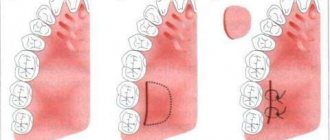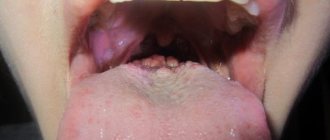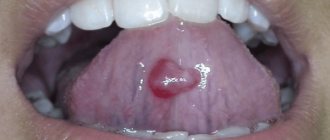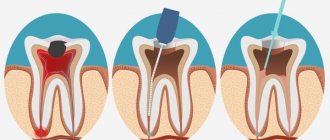Author: Oleg Maltsev
It happens that, without experiencing any visible health problems, you suddenly begin to be bothered by the obsessive sensation of a hair on your tongue. At first you don't give it any importance, since there are no visible changes in your language. However, this feeling visits you more and more often and begins to cause nausea and even vomiting.
Sensation of hair in the mouth
The structure of human language is much more complex than it might seem to the naked eye. Upon closer examination, it becomes clear that our tongue is covered with different types of processes, each of which performs its own function:
- Conical and filiform papillae;
- Mushroom-shaped;
- Grooved;
- Leaf-shaped.
All types of papillae work as receptors: filiform ones determine mechanical effects, groove-shaped and leaf-shaped ones determine taste.
The tongue is quite sensitive to chronic diseases of internal organs. By the condition and sensations on the tongue, you can determine the presence of a disease that you did not even imagine. The disease can be identified by color, plaque, cracks, wounds and ulcers.
The sensation of hair on the tongue is nothing more than enlarged thread-like processes in the mouth . The presence of such a diagnosis also signals possible disturbances in the functioning of our body.
Diagnostics
If a person complains that it is difficult for him to swallow, it is necessary to consult a doctor - an otolaryngologist, a therapist, an endocrinologist, and sometimes more specialized specialists - a cardiologist, a surgeon.
To make an accurate diagnosis, it is important to clearly formulate what feeling is bothering you, when and how it appeared. If a patient complains that there is something in the throat that is bothersome or sore, but there is no sharp pain, the following signs are decisive:
- presence of shortness of breath, suffocation;
- desire to cough up;
- discomfort when changing head position;
- pain when swallowing saliva, liquid or solid food;
- the time when the lump bothers you the most - during the day, at night, constantly;
- sensation of a foreign object;
- the right or left side is affected.
You also need to consider additional signs:
- tickling sensation;
- fear of choking, choking;
- heartburn, nausea;
- sensation of movement in the larynx.
Several types of examination are used to make a final diagnosis. First of all, an examination of the neck and throat is carried out, which is performed by a therapist, ENT specialist or endocrinologist.
Auxiliary methods:
- Ultrasound of the neck and thyroid gland.
- Clinical and biochemical tests of blood and urine.
- X-ray of the paranasal sinuses and cervical spine. They are complemented by tomography.
- Fibrogastroscopy, bronchoscopy.
Sometimes it is necessary to obtain the opinion of related specialists - a gastroenterologist, pulmonologist, oncologist, neurologist, and, with prior consent, a psychiatrist.
Causes of receptor hypertrophy
The main reasons causing the growth of papillae may be:
- Stomach diseases;
- Gastritis or colitis;
- Pancreatitis;
- Angina;
- Lobar pneumonia;
- Cancerous formations;
- Taking antibiotics;
- Fungal infections;
- Allergy.
In addition, the cause of changes in the mouth can be systematic irritation of the tongue mucosa. For example:
- Smoking;
- Taking pills;
- Using the wrong toothpaste;
- Poor oral hygiene;
- Eating unnatural foods;
- Frequent intake of spicy, sour, salty foods.
Symptoms of glossophytia
This problem has an official name - glossophytia. And it most often proceeds in accordance with the following stages:
- The filiform papillae grow. This may not be noticeable to the naked eye;
- The receptors become wider and denser, sometimes up to two mm in diameter;
- Next comes the keratinization stage;
- The color of the processes changes. At the beginning of the disease, the hairs become white, later changing their color to black.
In this case, patients often note the sensation of hair in the mouth. The more the disease progresses, the more often the situation is aggravated by nausea and vomiting from a foreign body. Therefore, the disease should be diagnosed and treated as early as possible.
In the absence of complications, the healing time fluctuates around a month.
Causes of throat discomfort
There are a lot of factors that cause discomfort in the throat. They can be either of internal origin or a consequence of external influences. Most often, discomfort in the tracheal area is observed in women.
Stress
Frequent stressful situations do not have the best effect on the body. One of the manifestations of disorders against the background of a nervous disorder may be a lump in the throat. The pattern of formation of this symptom is simple:
- with a nervous disorder, a person needs more air, so the vocal cords move to the edge of the larynx;
- if a stressful situation is accompanied by crying and screaming, additional stress is placed on the ligaments;
- due to excessive pressure on the larynx, the epiglottis rises slightly above the glottis and puts pressure on the surrounding tissues.
When a person calms down, all unpleasant sensations disappear. In this case, there is no need to take any medications - this is the body’s natural reaction to a stress factor. If the discomfort does not go away, this is a clear sign of a nervous spasm of the pharynx. Then you will need to seek help from a psychotherapist who will relieve the spasm and recommend treatment.
Digestive system disorders
If discomfort in the tracheal area appears even in moments of calm and rest, the reason for this may be a disorder of the digestive system. With heartburn and increased acid content in the stomach, part of its contents is thrown into the esophagus. This leads to burns of the mucous membrane and inflammation, which causes discomfort in the throat.
In this case, there is no need to take independent measures and self-medicate. It is recommended to contact a gastroenterologist for examination. He will assess the patient's condition and prescribe adequate treatment.
Thyroid enlargement
This is one of the most common causes of difficulty swallowing and discomfort in the Adam's apple area. This organ covers the trachea on both the right and left sides. The growth can also be localized on one side, or on the right or left. And if the thyroid gland enlarges, it begins to compress all the organs that are in the throat. Symptoms such as lump, soreness and cough appear. If you suspect that a lump in your throat is a consequence of thyroid disease, you should immediately contact an endocrinologist.
An enlarged thyroid gland affects all organs in the throat.
Inflammatory throat diseases
A feeling of a lump in the throat, accompanied by pain and soreness, is most often associated with a viral or bacterial infection. Discomfort in the tracheal area can be caused by two main factors:
- damage to the epithelial villi during acute pharyngitis (they are destroyed during severe infection and the throat becomes unprotected);
- outflow of mucus from the nose into the throat (this creates a feeling of a lump, you constantly want to cough up).
To get rid of unpleasant sensations, it is worth undergoing drug therapy aimed at treating a viral or bacterial infection.
Osteochondrosis
Difficulty breathing and discomfort in the Adam's apple area are often felt with problems in the cervical spine. Pinching of the nerve responsible for the functioning of the pharynx, esophagus and respiratory muscles leads to a feeling of constriction, creates breathing difficulties, and an imaginary sensation of a foreign object when swallowing. Dry mouth occurs, which is not helped by drinking plenty of fluids.
If treatment is not started promptly, the consequences can be negative for health. Shortness of breath will develop, turning into suffocation. Therapeutic measures usually prescribed for osteochondrosis are massage, recreational exercise and taking certain medications.
Foreign objects
Sometimes the feeling of a lump in the throat is caused by the presence of an object or piece of food there. A small tablet may get stuck in the esophagus or a small fruit seed may stick. The symptoms are as follows:
- painful sensations in the nasopharynx;
- constant desire to cough;
- nausea leading to vomiting.
If a small and non-hazardous object is stuck, you can try to push it through with plenty of drink or rough food. If dangerous or toxic objects (pills, needles, watch batteries) get into your throat, you should immediately seek help from a doctor.
During pregnancy, the sensation of a lump in the throat often causes toxicosis.
Treatment options
Even if you have determined the presence of the disease yourself, a doctor can best prescribe treatment and rule out complications. After examining and identifying the circumstances preceding the development of pathology, he will be able to advise you on a number of procedures and medications:
- Firstly, the oral cavity must be cleaned and disinfected from bacteria - possible infectious agents;
- For fungal diseases, you cannot do without appropriate medications;
- Enlarged hairs are recommended to be lubricated with a five percent solution of resorcinol;
- Salicylic alcohol is also prescribed;
- To remove hairs, cryo-freezing is used, as a result of which the keratinized hairs are destroyed;
- A complex of vitamins that strengthen the immune system is prescribed.
The need for tongue can only be a side effect if there is a more serious problem in the body. In such a case, you need to be examined for the presence of chronic diseases. When they are identified, it is necessary to treat both the original source and the consequences in the form of hair on the tongue.
To prevent the development of such a pathology, maintain oral hygiene, be attentive to your body, and undergo regular examinations by an otolaryngologist and dentist.
Associated symptoms
If there really is a hair in the oral cavity, then the person feels:
- The presence of a foreign object that makes swallowing difficult;
- Constant desire to expel it by expectoration.
You should know! It’s another matter if we are talking about more than just a single sensation of a hair on the tongue.
When a symptom accompanies a number of signs , and there is actually no hair in the oral cavity, then this indicates the development of serious diseases .
Along with this unpleasant feeling, the following symptoms may occur :
- Irritation of the nasopharynx , accompanied by painful swallowing;
- Sore throat and urge to cough ;
- Unpleasant dryness , causing a desire to wet the throat;
- Difficulty breathing and hoarseness of voice ;
- Fever, swelling and lethargy;
- Feeling of nausea and vomiting ;
- Nervous obsessive states ;
- Changing the color of the tongue.
The presence of at least one of the listed signs is a reason to visit a doctor .
Remember! Timely detection of pathology will help protect health from possible serious consequences.
Can hair grow on the tongue?
Based on all of the above, we can say with confidence that hair does not grow on the tongue . However, there is a pathology of the oral cavity, which is characterized by an increase in language receptors, very similar to hairs.
In reality, these receptors have nothing in common with the hair growing on the human body, either in structure or in function in the body.
Hair is keratinized epithelial cells. Unlike the papillae on the tongue, they do not have any receptors and are not able to detect taste or mechanical influences. However, quite often, thanks to their external similarity, we can detect the disease in time and take the necessary measures.
Thus, the sensation of a hair on the tongue can be quite harmless (in the case of stress), but it can become evidence of the presence of an oral disease , or, even worse, a manifestation of a much more serious pathological condition of the body.
Under no circumstances should such a symptom be ignored. If it occurs, you should immediately visit a doctor to conduct a comprehensive examination of the whole body and prescribe adequate treatment.
What if the hair is real?
Despite the fact that the sensation of a hair in the throat is a fairly common symptom of various pathologies, most often it appears due to the fact that a person actually has a small hair on the wall of the larynx. As a rule, hair gets into a person’s throat during visits to hairdressers or contact with animals.
If you can see the hair, you can try to swallow more saliva. The foreign body will slide down the esophagus and enter the stomach. After this, it will leave the body naturally.
It happens when neither swallowing nor drinking helps a person, then it is necessary to carefully examine the throat in the mirror. Sometimes you may even need a flashlight. There is another way to extract hair.








